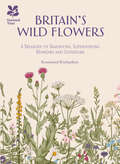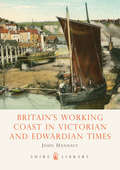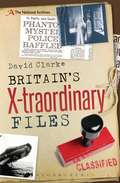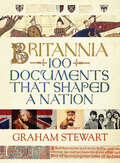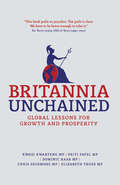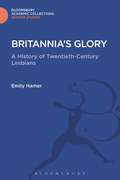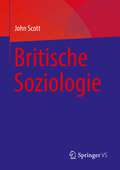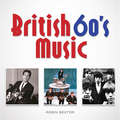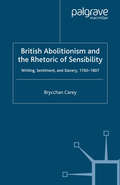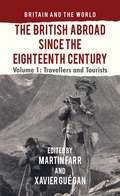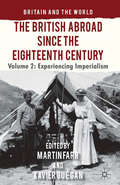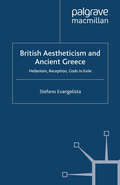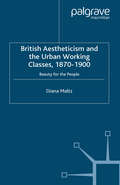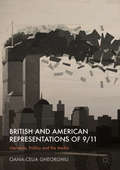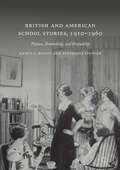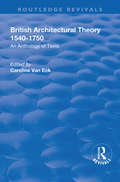- Table View
- List View
Britain's Wild Flowers
by Rosamond RichardsonA fascinating look at the myths, folklore and botany behind over 70 British wildflowers.
Britain's Working Coast in Victorian and Edwardian Times (Shire Library #548)
by John HannavyThe coastline of Victorian and Edwardian Britain provided beauty, entertainment and the venue for most people's holidays. But it was also a thriving centre of industry shipbuilding and fishing, plus the numerous trades associated with dockyards, coastal transport and the leisure industry. This book travels around Britain's coast clockwise from London looking at the industries that could be found at many of the cities and towns en route. Illustrated with an amazing collection of coloured postcards and other early photographs, the working coast of Britain is brought to life in all its bustling detail.
Britain's X-traordinary Files
by David ClarkeDavid Clarke opens The National Archives' own X Files to uncover the secret, official accounts behind legendary paranormal and extraordinary phenomena. From mediums employed by the police to help with psychic crime-busting to sea monster sightings reported to the Royal Navy, Britain's X-traordinary Files brings to light a range of secret documents created by military intelligence and government agencies who have investigated and even used extraordinary phenomena or powers in recent history. Each chapter is underpinned by original, official records held at The National Archives, which throw new light on many rumours and unsolved historical mysteries, including the Angels of Mons and other legends of the Great War plus a variety of strange phenomena reported both in the sea and in the air, from phantom helicopters to the great sea serpent of the Victorian era. The final chapter scrutinises official interest in the infamous Loch Ness Monster of Scotland and the 'Beast of Bodmin'. These accounts are supplemented with contextual material gathered from interviews and the author's own investigations, making truly eye-opening reading for anyone interested in the paranormal.
Britain's X-traordinary Files
by David ClarkeDavid Clarke opens The National Archives' own X Files to uncover the secret, official accounts behind legendary paranormal and extraordinary phenomena. From mediums employed by the police to help with psychic crime-busting to sea monster sightings reported to the Royal Navy, Britain's X-traordinary Files brings to light a range of secret documents created by military intelligence and government agencies who have investigated and even used extraordinary phenomena or powers in recent history. Each chapter is underpinned by original, official records held at The National Archives, which throw new light on many rumours and unsolved historical mysteries, including the Angels of Mons and other legends of the Great War plus a variety of strange phenomena reported both in the sea and in the air, from phantom helicopters to the great sea serpent of the Victorian era. The final chapter scrutinises official interest in the infamous Loch Ness Monster of Scotland and the 'Beast of Bodmin'. These accounts are supplemented with contextual material gathered from interviews and the author's own investigations, making truly eye-opening reading for anyone interested in the paranormal.
Britannia: Tribal Conflicts and the End of Roman Britain
by Stuart LaycockAttempts to understand how Roman Britain ends and Anglo-Saxon England begins have been undermined by the division of studies into pre-Roman, Roman and early medieval periods. This groundbreaking new study traces the history of British tribes and British tribal rivalries from the pre-Roman period, through the Roman period and into the post-Roman period. It shows how tribal conflict was central to the arrival of Roman power in Britain and how tribal identities persisted through the Roman period and were a factor in three great convulsions that struck Britain during the Roman centuries. It explores how tribal conflicts may have played a major role in the end of Roman Britain, creating a 'failed state' scenario akin in some ways to those seen recently in Bosnia and Iraq, and brought about the arrival of the Anglo-Saxons. Finally, it considers how British tribal territories and British tribal conflicts can be understood as the direct predecessors of the Anglo-Saxon kingdoms and Anglo-Saxon conflicts that form the basis of early English History.
Britannia: 100 Documents that Shaped a Nation
by Graham StewartIn Britannia Graham Stewart traces two thousand years of an island's story - from Roman province to twenty-first century European nation-state - through one hundred historic documents. From the eighth-century Lindisfarne Gospels to the great testament of Norman bureaucracy, the Domesday Book, and from the designs for the Union Jack in 1606 to Neville Chamberlain's 1938 Munich agreement with Hitler, the documents selected embrace a wide range of national endeavours: politics and religion, warfare and diplomacy, economics and the law, science and invention, literature and journalism, as well as sport and popular music. Thus the first edition of The Times rubs shoulders with the rules of the newly formed Marylebone Cricket Club; the designs for Stephenson's Rocket with the Catholic Emancipation Act; Lord Kitchener's iconic First World War recruitment poster with Clause Four of the Labour Party's constitution; and the Beatles' Sgt. Pepper album cover with Britain's accession treaty to the European Economic Community. These are documents that not only defined their own eras, but which continue to resonate today: Magna Carta and the Bill of Rights became vital legal curtailments of arbitrary royal power; medieval election writs and nineteenth-century reform acts shaped the creation of parliamentary democracy; the great translations of the Bible, the plays of Shakespeare and Dr Samuel Johnson's Dictionary have left indelible marks on the English language; while the influence of Adam Smith's Wealth of Nations continues to guide how we do business.Stylishly written and generously illustrated (including numerous reproductions of the documents themselves, twenty-four of them in full colour), Britannia should belong to anyone who is curious to learn more about the historic roots of our culture, society, language, religious traditions and political institutions.
Britannia Unchained: Global Lessons for Growth and Prosperity
by Kwasi Kwarteng P. Patel Dominic Raab Chris Skidmore Elizabeth TrussBritain is at a cross-roads; from the economy, to the education system, to social mobility, Britain must learn the rules of the 21st century, or face a slide into mediocrity. Brittania Unchained travels around the world, exploring the nations that are triumphing in this new age, seeking lessons Britain must implement to carve out a bright future.
The Britannias: An Island Quest
by Alice AlbiniaSHORTLISTED FOR THE EDWARD STANFORD TRAVEL BOOK OF THE YEAR'A dazzlingly brilliant book' Hannah Dawson'Fascinating, often exhilarating ... Albinia is an intrepid, imaginative guide' TLSThe Britannias tells the story of Britain's islands and how they are woven into its collective cultural psyche.From Neolithic Orkney to modern-day Thanet, Alice Albinia explores the furthest reaches of Britain's island topography, once known (wrote Pliny) by the collective term, Britanniae. Sailing over borders, between languages and genres, trespassing through the past to understand the present, this book knocks the centre out to foreground neglected epics and subversive voices.The ancient mythology of islands ruled by women winds through the literature of the British Isles - from Roman colonial-era reports, to early Irish poetry, Renaissance drama to Restoration utopias - transcending and subverting the most male-fixated of ages. The Britannias looks far back into the past for direction and solace, while searching for new meaning about women's status in the body politic. Boldly upturning established truths about Britain, it pays homage to the islands' beauty, independence and their suppressed or forgotten histories.
Britannia's Glory: A History of Twentieth Century Lesbians (Gender Studies: Bloomsbury Academic Collections)
by Emily HamerThis title traces the lives of individual lesbians against the background of the politics and history of the 20th century, and shows the infinite variety of ways in which lesbians made their lives in Britain. This history has relevance to contemporary life and politics within the lesbian community. British lesbians have a long tradition of diversity, of action, of success and of pride, which is documented here.
Britische Soziologie
by John ScottDieser Band bietet eine umfassende Geschichte der Soziologie in Großbritannien und verfolgt die Entwicklungen der Disziplin im institutionellen und politischen Kontext.Nachdem er die frühe Entwicklung des Fachs als intellektuelles Feld in empirischer und idealistischer Philosophie, Evolutionismus, Sozialismus und statistischen Untersuchungen nachgezeichnet hat, legt Scott den Weg der Soziologie als institutionalisierte Disziplin dar. Das Buch zeichnet die Ausbreitung des Fachs von der ersten soziologischen Abteilung an der London School of Economics bis hin zur Abdeckung des gesamten Landes nach und geht auf die Gründung bedeutender Berufsverbände und Fachzeitschriften sowie auf die Auswirkungen des Feminismus und des politischen Wandels ein. Scott gibt auch einen Überblick über die theoretische Auseinandersetzung mit dem Marxismus, dem Interaktionismus, dem Feminismus und dem Poststrukturalismus sowie über die Entwicklung der Disziplin durch Forschungsstudien zu Kriminalität, Rasse und ethnischer Zugehörigkeit, Gemeinschaft, Schichtung, Gesundheit, Sexualität und Arbeit.Vor dem Hintergrund eines sich wandelnden politischen Kontextes, in dem der Neoliberalismus und die Globalisierung zunehmen, und mit Blick auf die anhaltende Suche nach "neuen Wegen" leistet dieser Band eine Beitrag zur Verortung der Soziologie in einem globalen Kontext.
British 60s Music
by Robin BextorThe 1960s was simply the most exciting decade in music history known to man. The eruption of talent after the discovery of the Mersey Sound, spearheaded of course by the Fab Four, changed the world.What was special was that for a glorious and colourful short period of time, hardly a week went by without some new creative talent emerging on our airwaves, some new direction in music being created; something fresh to excite us being presented for our edification. Looking back at the charts week by week you realise that there was an explosion in song writing, a huge growth in people being interested in music and, as a result, some really great sounds were made.In this book we have not tried to quantify that, or even order those bands and artists who helped to change our society and our way of looking at it, but we have created a top 40 of artists that can simply not be ignored for what they did. From artists such as Cliff Richard to The Kinks and Pink Floyd, The Rolling Sones and, of course, The Beatles!
British Abolitionism and the Rhetoric of Sensibility: Writing, Sentiment and Slavery, 1760-1807 (Palgrave Studies in the Enlightenment, Romanticism and Cultures of Print)
by B. CareyBritish Abolitionism and the Rhetoric of Sensibility argues that participants in the late eighteenth-century slavery debate developed a distinct sentimental rhetoric, using the language of the heart to powerful effect in the most important political and humanitarian battle of the time. Examining both familiar and unfamiliar texts, including poetry, novels, journalism, and political writing, Carey shows that salve-owners and abolitionists alike made strategic use of the rhetoric of sensibility in the hope of influencing a reading public thoroughly immersed in the 'cult of feeling'.
The British Abroad Since the Eighteenth Century, Volume 1: Travellers and Tourists (Britain and the World)
by Xavier GuéganThis book considers the British travelling beyond their isles over the last three hundred years, and through a range of interdisciplinary perspectives reflects on their taste for discovery and self-discovery both through the exploration – and exploitation – of other lands and peoples.
The British Abroad Since the Eighteenth Century, Volume 2: Experiencing Imperialism (Britain and the World)
by Xavier GuéganThis is a collection of twelve interdisciplinary essays from international scholars concerned with examining the British experience of Empire since the eighteenth century. It considers themes such as national identity, modernity, culture, social class, diplomacy, consumerism, gender, postcolonialism, and perceptions of Britain's place in the world.
British Aestheticism and Ancient Greece: Hellenism, Reception, Gods in Exile (Palgrave Studies in Nineteenth-Century Writing and Culture)
by S. EvangelistaThis book is the first comprehensive study of the reception of classical Greece among English aesthetic writers of the nineteenth century. By exploring this history of reception, it aims to give readers a new and fuller understanding of literary aestheticism, its intellectual contexts, and its challenges to mainstream Victorian culture.
British Aestheticism and the Urban Working Classes, 1870-1900: Beauty for the People (Palgrave Studies in Nineteenth-Century Writing and Culture)
by D. MaltzThis cultural study reveals the interdependence between British Aestheticism and late-Victorian social-reform movements. Following their mentor John Ruskin who believed in art's power to civilize the poor, cultural philanthropists promulgated a Religion of Beauty as they advocated practical schemes for tenement reform, university-settlement education, Sunday museum opening, and High Anglican revival. Although subject to novelist's ambivalent, even satirical, representations, missionary aesthetes nevertheless constituted an influential social network, imbuing fin-de-siecle artistic communities with political purpose and political lobbies with aesthetic sensibility.
British and American News Maps in the Early Cold War Period, 1945–1955: Mapping the "Red Menace" (Palgrave Studies in the History of the Media)
by Jeffrey P. StoneDuring the early years of the Cold War, England and the United States both found themselves reassessing their relationship with their former ally the Soviet Union, and the status of their own “special relationship” was far from certain. As Jeffrey P. Stone argues, maps from British and American news journals from this period became a valuable tool for relating the new realities of the Cold War to millions of readers. These maps were vehicles for political ideology, revealing both obvious and subtle differences in how each country viewed global geopolitics at the onset of the Cold War. Richly illustrated with news maps, cartographic advertisements, and cartoons from the era, this book reveals the idiomatic political, cultural, and material differences contributing to these divergent cartographic visions of the Cold War world.
British and American Representations of 9/11: Literature, Politics and the Media
by Oana-Celia GheorghiuThis book argues that twenty-first-century neorealist fiction is inspired by political and journalistic discourses and, along with them, constitutes one of the many representations of the attacks on September 11 and their outcomes. Adopting a neorealist stance, this book is placed at the intersection of realism and fiction, with often reference to what is perceived as objective writing (media and political texts), not at all so divorced from the practice of literary writings on the event that shook the world on September 11, 2001.
British and American Representations of 9/11: Literature, Politics and the Media
by Oana-Celia GheorghiuThis book argues that twenty-first-century neorealist fiction is inspired by political and journalistic discourses and, along with them, constitutes one of the many representations of the attacks on September 11 and their outcomes. Adopting a neorealist stance, this book is placed at the intersection of realism and fiction, with often reference to what is perceived as objective writing (media and political texts), not at all so divorced from the practice of literary writings on the event that shook the world on September 11, 2001.
British and American School Stories, 1910–1960: Fiction, Femininity, and Friendship
by Nancy G. Rosoff Stephanie SpencerThis book examines school and college fiction for girls in Britain and the United States, written in the first half of the twentieth century, to explore the formation and ideologies of feminine identity. Nancy G. Rosoff and Stephanie Spencer develop a transnational framework that recognises how both constructed and essential femininities transcend national boundaries. The book discusses the significance and performance of female friendship across time and place, which is central to the development of the genre, and how it functioned as an important means of informal education. Stories by Jessie Graham Flower, Pauline Lester, Alice Ross Colver, Elinor Brent-Dyer, and Dorita Fairlie Bruce are set within their historical context and then used to explore aspects of sociability, authority, responsibility, domesticity, and possibility. The distinctiveness of this book stems from the historical analysis of these sources, which have so far primarily been treated by literary scholars within their national context.Winner of the History of Education Society Anne Bloomfield Prize for the best book on history of education published in English 2017-19
The British Anti-Psychiatrists: From Institutional Psychiatry to the Counter-Culture, 1960-1971 (Routledge Studies in Cultural History #54)
by Oisín WallThe British anti-psychiatric group, which formed around R.D. Laing, David Cooper, and Aaron Esterson in the 1960s, burned bright, but briefly, and has left a long legacy. This book follows their practical, social, and theoretical trajectory away from the structured world of institutional psychiatry and into the social chaos of the counter-culture. It explores the rapidly changing landscape of British psychiatry in the mid-Twentieth Century and the apparently structureless organisation of the part of the counter-culture that clustered around the anti-psychiatrists, including the informal power structures that it produced. The book also problematizes this trajectory, examining how the anti-psychiatrists distanced themselves from institutional psychiatry while building links with some of the most important people in post-war psychiatry and psychoanalysis. The anti-psychiatrists bridged the gap between psychiatry and the counter-culture, and briefly became legitimate voices in both. Wall argues that their synthesis of disparate discourses was one of their strengths, but also contributed to the group’s collapse. The British Anti-Psychiatrists offers original historical expositions of the Villa 21 experiment and the Anti-University. Finally, it proposes a new reading of anti-psychiatric theory, displacing Laing from his central position and looking at their work as an unfolding conversation within a social network.
The British Anti-Psychiatrists: From Institutional Psychiatry to the Counter-Culture, 1960-1971 (Routledge Studies in Cultural History #54)
by Oisín WallThe British anti-psychiatric group, which formed around R.D. Laing, David Cooper, and Aaron Esterson in the 1960s, burned bright, but briefly, and has left a long legacy. This book follows their practical, social, and theoretical trajectory away from the structured world of institutional psychiatry and into the social chaos of the counter-culture. It explores the rapidly changing landscape of British psychiatry in the mid-Twentieth Century and the apparently structureless organisation of the part of the counter-culture that clustered around the anti-psychiatrists, including the informal power structures that it produced. The book also problematizes this trajectory, examining how the anti-psychiatrists distanced themselves from institutional psychiatry while building links with some of the most important people in post-war psychiatry and psychoanalysis. The anti-psychiatrists bridged the gap between psychiatry and the counter-culture, and briefly became legitimate voices in both. Wall argues that their synthesis of disparate discourses was one of their strengths, but also contributed to the group’s collapse. The British Anti-Psychiatrists offers original historical expositions of the Villa 21 experiment and the Anti-University. Finally, it proposes a new reading of anti-psychiatric theory, displacing Laing from his central position and looking at their work as an unfolding conversation within a social network.
British Architectural Theory 1540-1750: An Anthology of Texts
by Caroline Van EckThis title was published in 2003.Although it is often assumed that British writing on architectural theory really started in the 18th century, there is in fact a large corpus of writing on architecture pre-dating the introduction of Palladianism by Lord Burlington. Some of it, such as the English editions of Serlio and Palladio, belongs to the Vitruvian tradition. But many texts elude such easy classification, such as the prolonged (but hardly studied) discussions on church architecture, which are both in form and content very different from the way that theme was handled in Italian Renaissance treatises. This collection of English writing on architecture from 1540 to 1750 offers a large selection of fragments, some of them never published before. They discuss the nature of architecture, the practicalities of building, the sense of the past, religious architecture and classicism.
British Architectural Theory 1540-1750: An Anthology of Texts (Routledge Revivals Ser.)
by Caroline Van Eck Christy AndersonThis title was published in 2003.Although it is often assumed that British writing on architectural theory really started in the 18th century, there is in fact a large corpus of writing on architecture pre-dating the introduction of Palladianism by Lord Burlington. Some of it, such as the English editions of Serlio and Palladio, belongs to the Vitruvian tradition. But many texts elude such easy classification, such as the prolonged (but hardly studied) discussions on church architecture, which are both in form and content very different from the way that theme was handled in Italian Renaissance treatises. This collection of English writing on architecture from 1540 to 1750 offers a large selection of fragments, some of them never published before. They discuss the nature of architecture, the practicalities of building, the sense of the past, religious architecture and classicism.
The British Army in Palestine and the 1948 War: Containment, Withdrawal and Evacuation (Israeli History, Politics and Society)
by Alon KadishFollowing the end of the Second World War, the main mission of the British Army in Palestine was to contain Jewish attacks and illegal immigration while the fate of the Mandate was being decided. This book is a record of the British Army during the final year of the Mandate and its impact on the course and outcome of the 1948 War.With the decision of the UN General Assembly on 29th November 1947 to partition Palestine and the anticipated eruption of inter-communal violence, the Army was made responsible for the maintenance of law and order throughout Palestine until the termination of the Mandate on 15th May 1948. These crucial months are considered from the point of view of the ranks of the British Army, soldiers and field commanders rather than that of generals and statesmen. It makes extensive use of memoirs, contemporary writing and private diaries, as well as archival material and regimental journals. Subjects such as regimental culture and leisure activities are explored in addition to operations and peace-keeping.The book offers an important contribution to the history of the Middle East, and readers interested in political science, the history of the British Army, military history, Palestine and Israel will find in this book a new and innovative view of the 1948 War.
